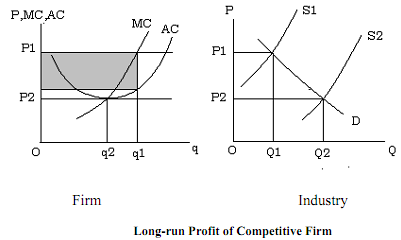Long-run Equilibrium of Firm and Industry:
In the long-run, all the inputs available to the firms are variable, so that the concept of fixed cost is absent and the total cost (TC) equals the total variable cost (TVC). Therefore, we need only to deal with the long-run average cost (LAC = LTC/q). We assume the LAC to be U-shaped exhibiting the fact that at the low levels of output, the cost is falling and beyond a point, it rises.
We have stated above that a perfectly competitive market is characterised by free entry and exit of the firms. As in the short-run, the firms are making profits, there will be entry of new firms in the market. As a result, the industry supply would go up and price would fall. This would continue until the profits are driven down to zero.
Such a process is described in the following diagram.

In figure at price. P1, the firm is producing an output q1 whereby it is making a profit shown by the shaded area. At price, P1, the industry output is Q1. As the existing firms are making profit, there will be entry into the market. As a result, the total supply in the market would go up and the price in market would fall. If at the new price the firms are still making some profit, then there will be further entry and market supply would go up.
Consequently, the price would go down further level. This process would continue until the price falls to such a level that all profits are eliminated.
From the diagram, the shaded area ceases to exist. This price is P2, where P = MC= AC and therefore profit is zero. The zero profit scenario faced by the firms means that the economic profit is zero implying that the firms earn no more than they would elsewhere. In other words, the firms are breaking even at price P2. At P2, as the firms are earning zero profit, there is no incentive for other firms to enter the industry. Hence, price P2 would represent an equilibrium price level with Q2 as the equilibrium output. With that the long-run equilibrium is characterised by a situation where the economic profits for the firms are zero.